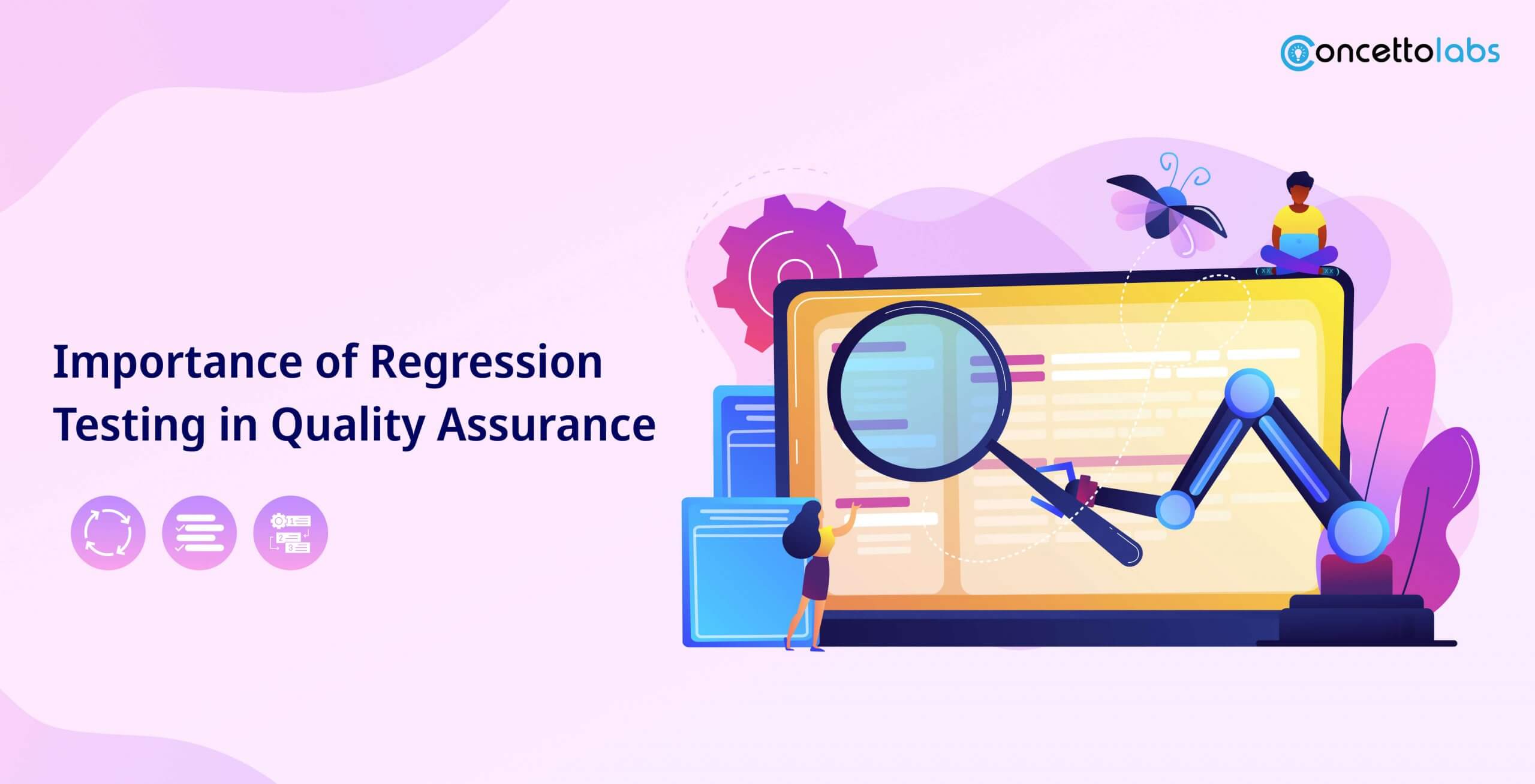
Summary: Check out the importance and power of regression testing in quality assurance and how it safeguards software against bugs. Also, learn how Concetto Labs automated regression testing services help your software to manage tasks seamlessly.
A crucial component of creating high-quality software is testing. Although regression testing in Quality Assurance is one of the most crucial and time-consuming aspects of testing, it is also one of the most error-prone. To make sure that new and live functionalities of an application continue to perform properly, testers run regression tests. In this testing strategy, the quality analyst examines both the functional and non-functional parts of the current features to make sure there are no new problems or faults in the application.
Regression testing goes beyond simply repeating past test cases; it makes sure that new features work with the current ones without causing current or future system failures. To guarantee that your software is always functional and meets or surpasses your expectations, Concetto Lab offers the best software regression testing services.
You must first understand what a software regression testing example is before you can appreciate its significance and advantages. Regression testing guarantees that the program continues to work as intended following updates, code changes, integration with third-party programs, etc.
What is Regression Testing?
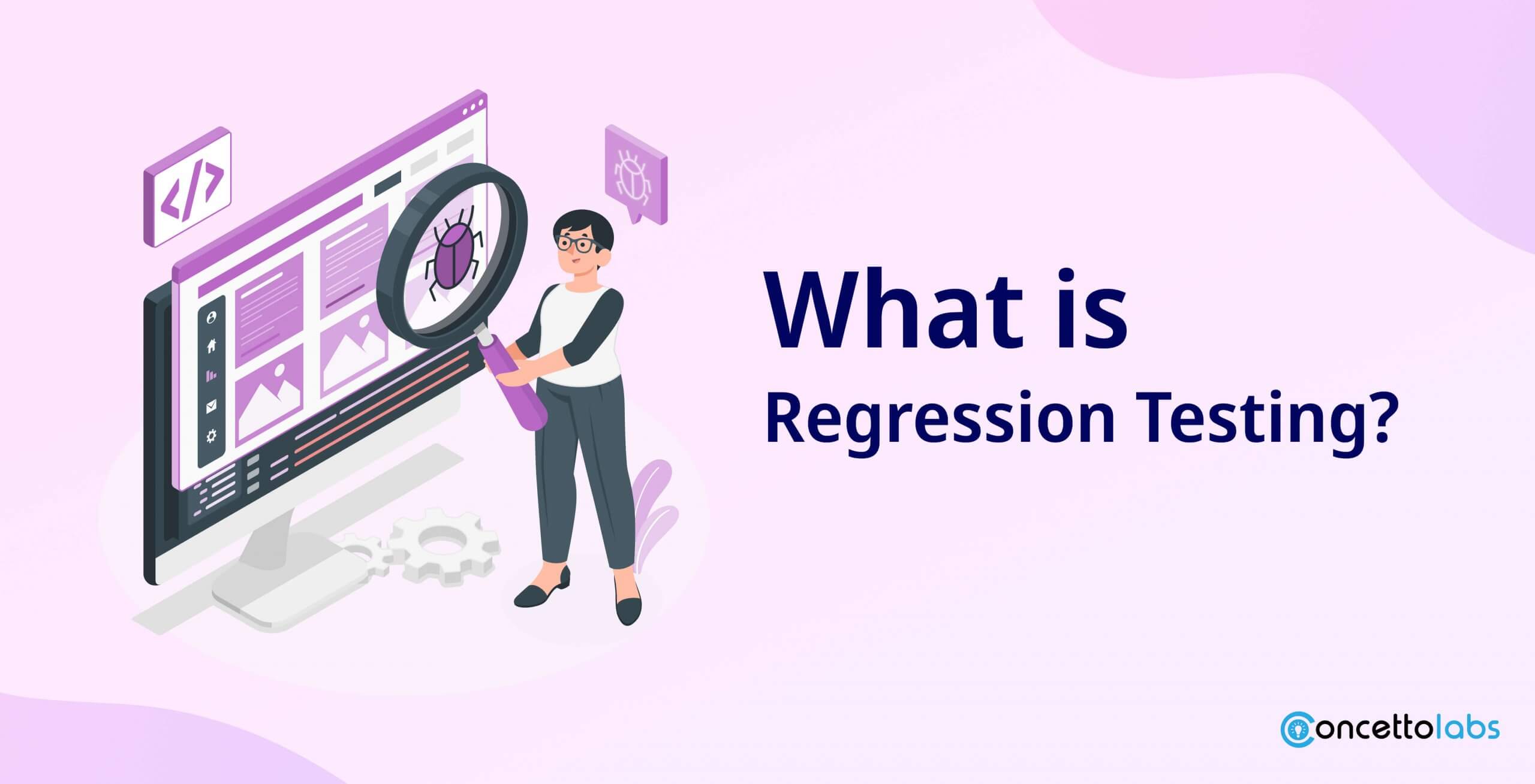
Fundamentally, regression testing in Quality Assurance involves going over previously tested code again to make sure that recent modifications haven’t affected current functioning. When adding new features, modifying current ones, or fixing faults in software, this type of testing is crucial. Its main objective is to detect any unexpected consequences that these modifications may have on the software’s intended non-changing components.
Example: A group of developers creates an online e-commerce store. To examine every facet of the application, the testing team develops a thousand test cases. The QA team does regression testing by generating 100 new test cases and running the prior 1000 again after introducing new features or upgrades. This guarantees the software remains high-quality and the website functions as planned.
Regression testing becomes even more crucial when programs become more complicated since changes made to one part of the code may affect other parts that developers may have considered to be “safe.”
What is the Importance of Regression Testing?
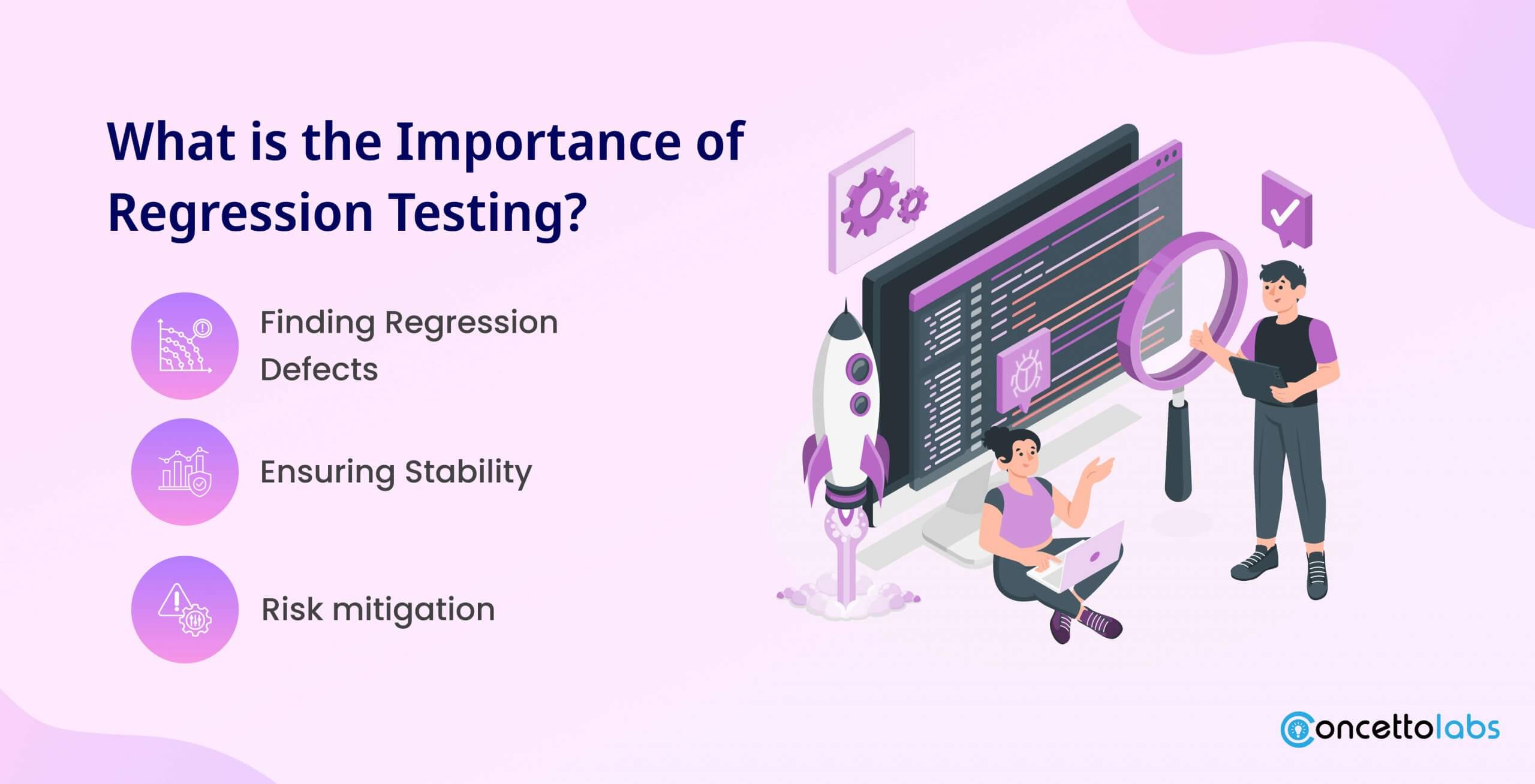
Imagine that after adding a new feature, users are unable to log in at all. Regression testing is useful in this situation. By identifying problems early on, it stops these kinds of catastrophes before they get worse.
Regression testing ensures that the addition of new features hasn’t unintentionally impacted any of the software’s already-existing functionalities. Because the repository of test cases from past software releases grows, it becomes more and more important as software ages.
Regression testing is necessary to assess the application’s general functionality following changes made for a variety of reasons, such as:
1. Finding Regression Defects: Regression testing aids in the identification of any inadvertent flaws or problems that might have been introduced during the creation or modification of software. These tests aid in evaluating the upgrade’s functioning. Regression tests find any faults or bugs in the application’s current functions and make sure the change doesn’t affect the software’s existing features. It also aids in finding errors in the recently pushed code.
2. Ensuring Stability: This type of testing confirms that after modifications, the software’s current functionality is still present. It contributes to the software’s stability by assisting in the detection of any unusual behavior or problems that can affect the user experience.
3. Risk mitigation: It involves identifying and reducing potential hazards connected to changes through thorough regression testing. It assists in averting unforeseen problems, system malfunctions, or performance deterioration that can affect user happiness or corporate operations.
What are the Types of Regression Testing?
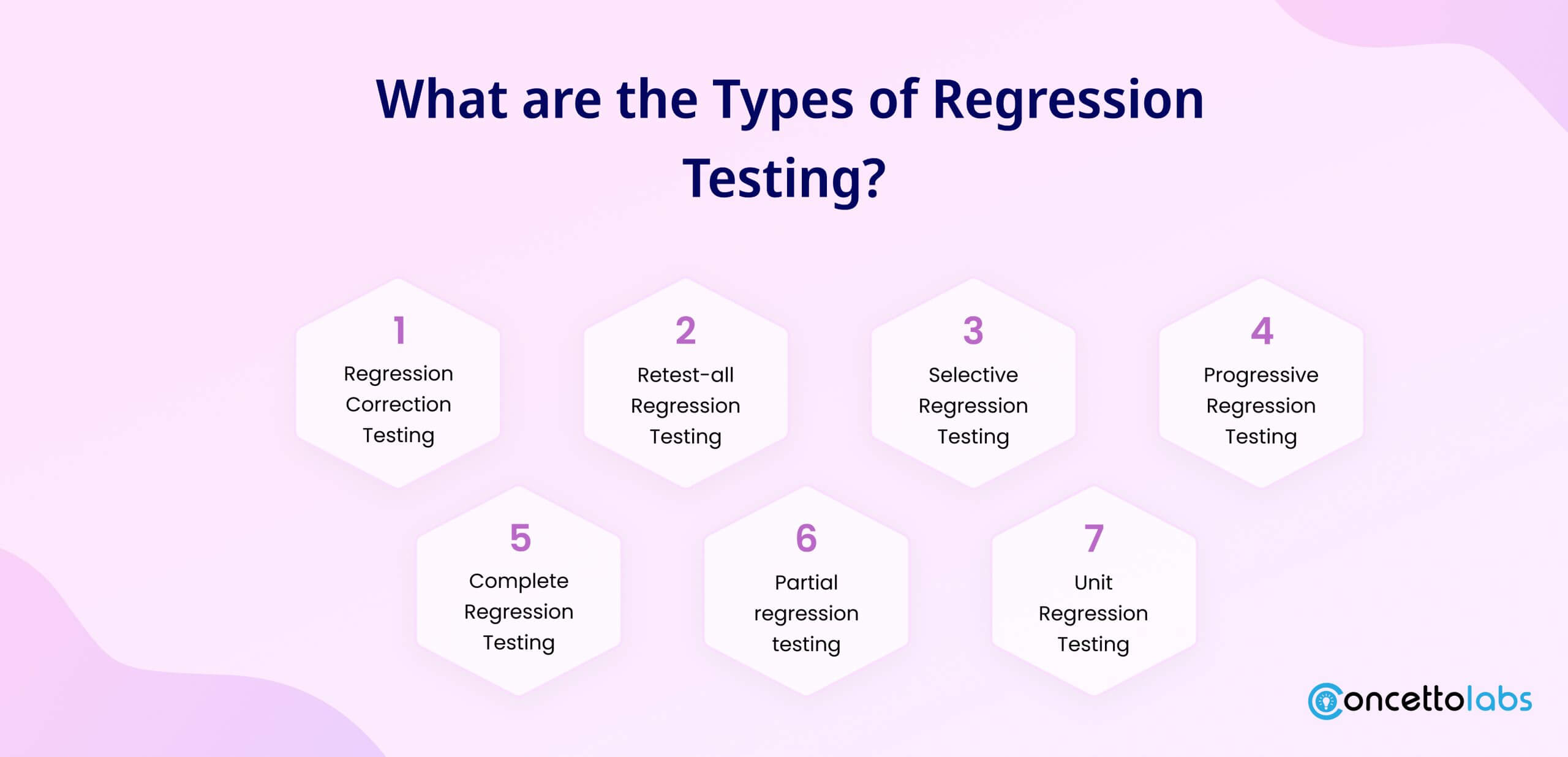
In software development, regression testing comes in a variety of forms. Here are the main categories.
1. Regression Correction Testing: is employed when the product specification remains unchanged.
2. Retest all Regression Testing: Check that all system specs are as stated in the original document and examine any small modifications made to the software.
3. Selective Regression Testing: Utilizing a portion of the current test cases, selective regression testing reduces the time and expense required for retesting by determining how the code responds to the addition of new code.
4. Progressive Regression Testing: Developing new test cases and making particular program modifications results in meaningful outputs from progressive regression testing.
5. Complete Regression Testing: When there are frequent modifications made to the current code or when the new updates significantly affect the software as a whole, complete regression testing is used.
6. Partial regression testing: Verifies that a system operates as intended and confirms problems that arise when new code is merged into an existing one.
7. Unit Regression Testing: Code units independently, without dependencies or interactions, is the primary focus of unit regression testing.
What are the Reasons to Invest in Regression Testing?
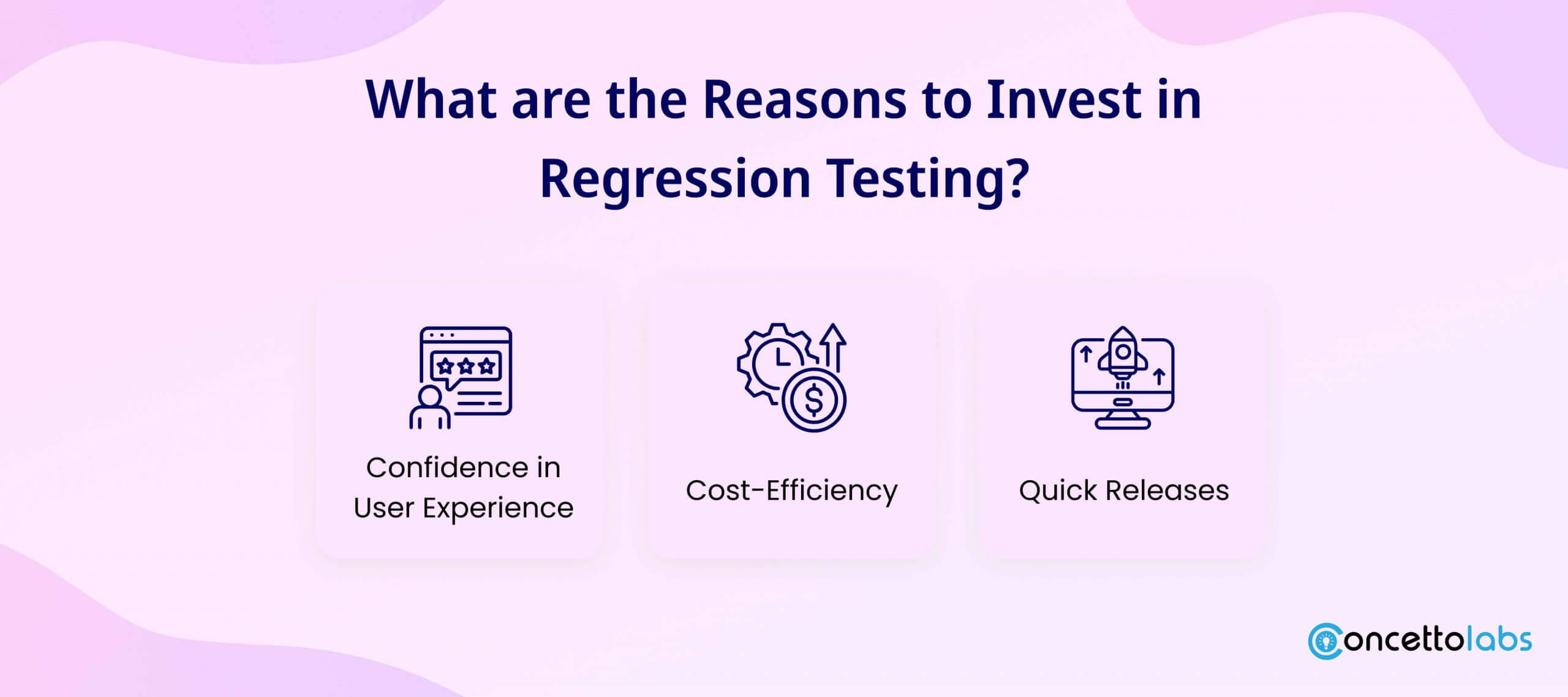
It should be quite clear from the statement above why regression testing is important: it ensures that an application’s code modifications don’t affect its ability to function as intended.
However, a closer examination reveals that the advantages of effective regression testing fall into three main categories:
1. Confidence in User Experience: It is no secret that users have higher expectations than ever before. A single bug, no matter how small, can have a big influence on user retention and satisfaction for customer-facing applications. Regression testing done correctly guarantees a stable and error-free user experience, building user loyalty and trust.
2. Cost-Efficiency: Although regression testing may appear to be an extra expense, it is significantly less expensive than post-release patch costs, particularly when taking into account the potential loss of customer trust and reputational harm.
3. Quick Releases: Regression testing gives teams the safety net they require in settings that prioritize continuous delivery or quick release cycles. Teams can roll out updates and new features more quickly and with confidence knowing that modifications haven’t affected any of the features that are already in place.
Benefits of Regression Testing
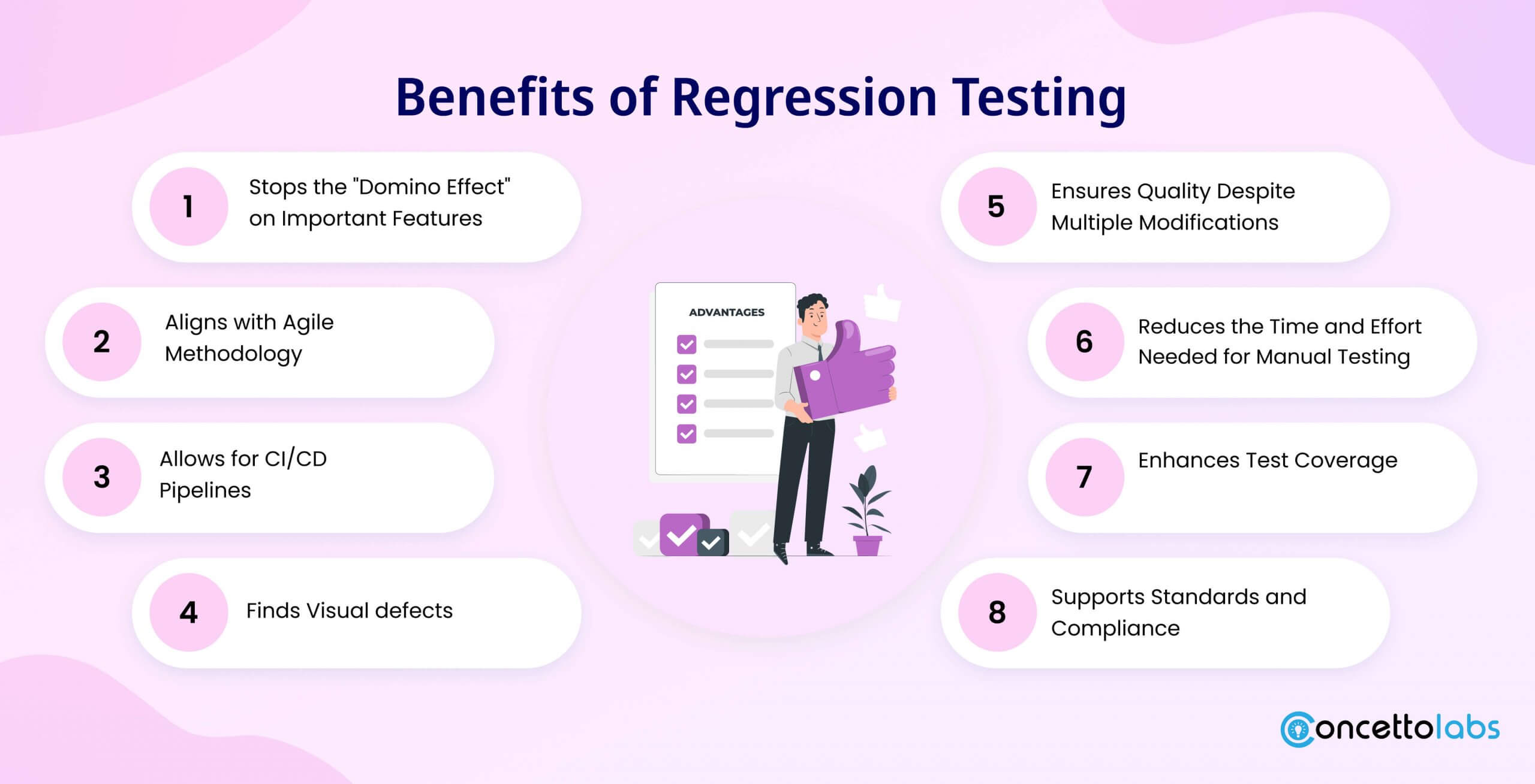
1. Stops the “Domino Effect” on Important Features
Modifications to the code, no matter how small, can have a big impact on important features of the product. Regression testing aids in the early detection of these problems, averting significant efforts to undo the harm.
2. Aligns with Agile Methodology
By continuously iterating, integrating, and testing new code, regression testing promotes Agile principles. This prevents a build-up of broken code as the production date approaches by enabling more frequent releases and quicker feedback loops.
3. Allows for CI/CD Pipelines
Regression testing is one of the automated tests used by Continuous Integration/Continuous Deployment (CI/CD) to make sure that new code integrations are continuously tested. This finds optimization options, such UX enhancements, in addition to helping detect problems.
4. Finds Visual defects
Visual regression testing is essential for identifying visual defects brought on by code modifications. Regression testing is not just about functionality. Automated regression testing are a fast way to find problems with different devices and browsers, such as non-clickable buttons or misaligned graphics.
5. Ensures Quality Despite Multiple Modifications
Regression testing serves as a quality filter for products that experience numerous modifications. It makes sure that every change makes the product better without creating new problems.
6. Reduces the Time and Effort Needed for Manual Testing
Automated regression tests greatly reduce the time and effort required for manual testing. QA teams can concentrate on more intricate testing scenarios and other important responsibilities because of this efficiency.
7. Enhances Test Coverage
Regression testing on a regular basis covers more ground in terms of testing the application over time. This thorough approach contributes to the preservation of overall software quality.
8. Supports Standards and Compliance
Regression testing on a regular basis guarantees that the application complies with regulatory requirements and industry standards, which is crucial for preserving the security and integrity of the final product.
Boost your Software’s Performance with our top-notch Regression Testing Services!
Contact UsHow to Perform Regression Tests on Software or Websites?
To conduct these tests, follow these three steps:
Step 1: Test data, test cases, test scripts, and other necessary resources must be ready to conduct human and automated tests.
Step 2: Determine which updates or modifications to the application’s current modules may affect its functionality: To concentrate your testing efforts, you must clearly define the portions of the application that will be impacted by the upgrades or modifications.
Step 3: Once the impacted functionalities have been identified, you may utilize both manual and automated tests to confirm that the upgrades or changes have not had a negative impact on those functionalities.
The most often occurring regressions that require testing involve features like checkout, search, and log in. You can use a variety of techniques, including functional testing, comparing the application’s output to expected outcomes, and employing automated testing tools like Concetto Labs, to find these regressions.
Factors to Set Up Regression Testing Module Strategy
Developing a strong regression testing plan is essential to maintaining software quality as it changes. Here’s a quick start guide to get you going:
1. Evaluate Your Application: To begin, make sure you comprehend the structure and elements of your application. The testing focus will be determined by identifying the more vulnerable regions, have high business effects, and are change-prone.
2. Set Test Case Priorities: Testing everything at all times is not practical. Determine which functionalities are essential and which, if damaged, would have the most impact based on your assessment. Additionally, note sections that undergo frequent modifications as these are more prone to new flaws.
3. Test Data Management: Make sure you have a solid plan in place for obtaining test data, either synthetic or genuine (anonymized). It’s crucial to strike a balance between data quality, realism, and privacy, as this article will discuss later.
4. Select a Testing Mix: Select a combination of full regression tests and partial (or targeted) tests based on the size and frequency of releases of the application. For example, large releases require comprehensive regression, whereas hotfixes may only require targeted testing.
5. Automate Strategically: Manual testing is time-consuming and prone to irregularities. For automation testing services to achieve speed and accuracy, identify high-priority and repetitive test cases.
6. Continuous Integration: Include your regression tests in an environment that uses Continuous Integration (CI). This guarantees that tests are launched automatically each time a change is made to the code, encouraging prompt feedback to the development team.
7. Examine and Revise: Update and examine your regression test suite on a regular basis. Certain tests might become outdated as the software develops, and new ones will have to be added.
You’ll need specialized tools to put these techniques into practice (the testing landscape is full of various tools; the list below is not an entire list, but rather a brief synopsis of several well-known alternatives):
8. Test Automation: Manually doing regression tests is simply unmanageable, particularly for large-scale applications. Selenium and Playwright used for web applications testing services and Appium for mobile applications testing services are a few well-liked options to take into account when automating application tests;
9. CI/CD Integration: To fully utilize automation and create a smooth workflow, you may incorporate regression testing into your development pipeline with the aid of tools such as Travis CI or Jenkins.
10. Data management: To create, store, and use your test data, you may require a variety of tools, depending on the data method you choose.
What are the Challenges Faced in Regression Testing?
Regression testing presents the following difficulties:
- Test suites typically get larger as regression testing goes on. However, it becomes challenging to run the full test suite because of time and financial constraints.
- Setting up regression tests at regular intervals—for example, after each build update, modification, or problem fix—is difficult and needs careful planning.
- It can be difficult to strike a compromise between maximizing test coverage and reducing the size of the test suite.
Final Thoughts
Effective regression testing is crucial to ensuring that both new and old software features work together as part of a thorough QA testing plan. Businesses can gain more control over their costs, efforts, resources, and time by investing in the careful development and implementation of regression testing procedures. This tactical approach highlights the critical role that QA testing plays in the development process and makes a substantial contribution to improving the quality of software products with quality engineering services.
Using the right tools, adhering to best practices, and comprehending the many forms of regression testing can all assist to speed up the regression testing procedure. Therefore, keep in mind the value of careful planning and its influence on the overall quality of software if you are thinking of cutting regression testing to achieve deadlines.







 Indonesia
Indonesia
 Botswana
Botswana
 USA
USA
 Italy
Italy
 Panama
Panama




 USA
USA UK
UK Saudi Arabia
Saudi Arabia Norway
Norway India
India Australia
Australia